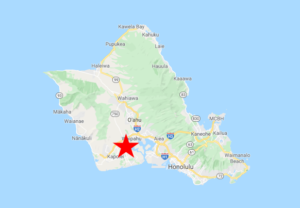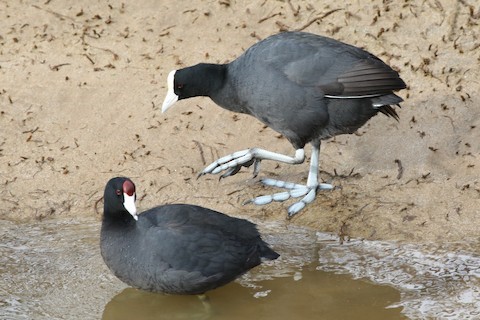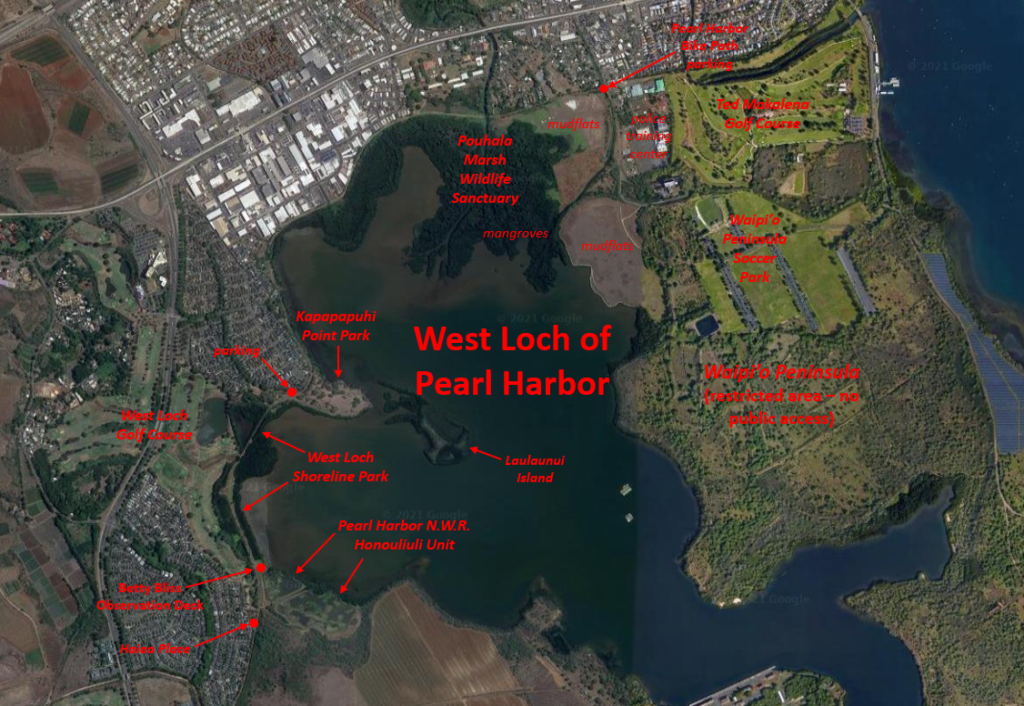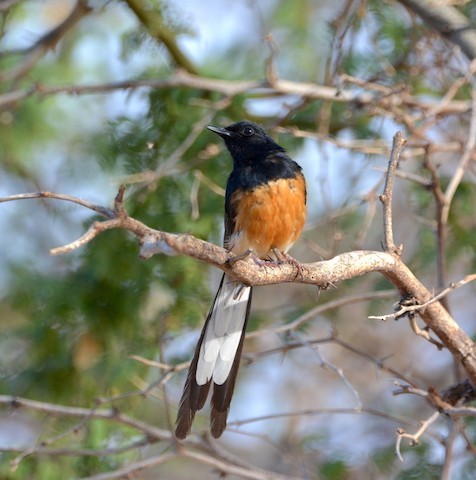West Loch, Pearl Harbor, Oahu, Hawaii

Pearl Harbor is an unusually extensive marine lagoon system that has a narrow entrance from the ocean, then forks into three bays or lochs. The eastern and central portions are mostly off-limits, but the West Loch has some partly accessible wetlands that are managed to preserve some of Pearl Harbor’s natural heritage. In addition to many migrants, three of Hawaii’s endemic waterbirds are common residents: “Hawaiian Gallinule”, Hawaiian Coot, and “Hawaiian Stilt”. The brushy and grassy margins support large numbers of introduced birds, including Gray Francolin, White-rumped Shama, and six waxbill species, including Red Avadavat.
Orientation
Directions
The West Loch of Pearl Harbor is in south-central Oahu, south of the H1 freeway where it passes beside the town of Waipahu, about 20 minutes’ drive (13 miles) from Daniel K. Inouye International Airport, or 30 minutes (20 miles) from downtown Honolulu.
To Kapapapuhi Point Park. Kapapapuhi Point Park is the approximate center of West Loch for birdwatching purposes. To reach it from downtown Honolulu or the airport, take the H1 freeway west. Just past Pearl City, the freeway forks, as the H2 heads north into the central valley of Oahu.
From the Pearl City fork, remaining on the H1 for another four miles, then exit onto Fort Weaver Road (Route 76) southbound. About a mile down this road, turn left onto Laulaunui Street. Then take the second right onto Kapapapuhi Street, and go 0.3 miles to its dead-end, which is a small parking area for Kapapapuhi Point Park. The Betty Bliss Observation Deck, overlooking the Honouliuli ponds, is a half-mile walk south of this parking area.
To West Loch Estates. The closest spot to the ponds where streetside parking is generally available is Haiea Place in West Loch Estates. To reach this spot from the H1, exit onto Fort Weaver Road southbound, as above, but do not turn onto Laulaunui Street.
Instead, continue an additional three-quarters of a mile and turn left onto A’awa Drive. After a half-mile, turn left onto Hamana Street. The take the second left onto Aipo’ola Street, then the first right onto Haiea Place. The cul-de-sac gives access to a paved bike path, where it is a 300-yard walk north to the observation deck. Parking on the cul-de-sac itself is prohibited, but otherwise streetside parking is generally allowed.
To Pouhala Marsh (Pearl Harbor Bike Path Parking). If going directly to Pouhala Marsh, it is more efficient to exit the H1 in Pearl City, immediately before the freeway forks. Take Exit 8B toward Waipahu. The exit ramp merges into the Farrington Highway westbound.

The endemic “Hawaiian Gallinule” is limited to wetlands on Kauai and Oahu. It differs from continental Common Gallinules in having more extensively black plumage and a large red frontal shield. © Noam Markus
Remain on Farrington Highway for 1.5 miles, then turn left onto Waipahu Depot Street. Streetside parking is generally available about a quarter-mile south, where this street crosses the Pearl Harbor Bike Path.
Birdfinding
Pearl Harbor’s western arm (i.e., its West Loch) has two productive wetland areas that are partly accessible to birdwatchers: (1) the Honouliuli Unit of Pearl Harbor National Wildlife Refuge; and (2) Pouhala Marsh. Both support resident populations of three endemic waterbirds: “Hawaiian Gallinule”, Hawaiian Coot, and “Hawaiian Stilt”. Both also have a history of hosting interesting migrants and vagrants originating from either North America or Asia.
Over the years, the Honouliuli Unit has accumulated a more impressively diverse list of vagrants, but both sites are worth visiting. Depending on the weather conditions, season, and time of day, etc., Pouhala Marsh could offer better prospects.

The endemic Hawaiian Coot has a large frontal shield that can be either pale or maroon. © Margaret Viens

Honouliuli Ponds. The Honouliuli Unit consists of two large impoundments, an area of about 37 acres. Note that the entire area is fenced off, so access is limited to a well-constructed observation platform (the “Betty Bliss Observation Deck”), which overlooks the western pond (“Pond A”). A dirt road south from the observation deck along the western fenceline allows for some additional perspective on Pond A, and it leads to an unofficial trail along the southern fenceline that has been used to view the much-larger Pond B to the east—but access to an unofficial trail cannot be guaranteed.
Several species of waterfowl are regular winter visitors. Many more have occurred as vagrants—including two Garganey during 2017-18 and one or two Cackling Geese on a semi-resident basis.

The West Loch of Pearl Harbor is among the most likely places in the U.S. to find a Sharp-tailed Sandpiper. © Eric VanderWerf
The expected wading birds, Black-crowned Night-Heron and Western Cattle Egret, are reliably present. Since the early 2010s, White-faced Ibis has been found at Honouliuli as consistently as anywhere in Hawaii, and its numbers, though small, have generally been increasing. The vagrants Great Blue Heron and Great Egret have both occurred at least once.
The common shorebirds essentially year-round are Pacific Golden-Plover and Ruddy Turnstone, with Wandering Tattler and Sanderling often present. They are often joined by less-expected seasonal visitors that have repeatedly included Sharp-tailed Sandpiper (up to 9 at once in 2017). Vagrants from Asia have included Bar-tailed Godwit, Ruff, Curlew Sandpiper, Little Stint, Common Snipe, Gray-tailed Tattler, and Marsh Sandpiper.
Brushy areas around the ponds and along the path from Kapapapuhi Point Park are especially good for Gray Francolin and White-rumped Shama, in addition to the other widespread introduced species of Oahu. Although relatively uninteresting to most North American birdwatchers, the site is also notably consistent for Mourning Dove, an introduced species that is generally uncommon in Hawaii.

Male White-rumped Shama at Kapapapuhi Point Park. © Miko Tokuhama-Olsen
The wet grassy margins of the ponds attract six species of waxbill. This is possibly the most consistent site in the U.S. to find Red Avadavat. The other estrildids that occur regularly are African Silverbill, Common Waxbill, Scaly-breasted and Chestnut Munias, and Java Sparrow. Additional introduced finches that are always or often present include House Finch, Yellow-fronted Canary, Northern and Red-crested Cardinals, and Saffron Finch.
Pouhala Marsh. The area called Pouhala Marsh includes the officially designated Pouhala Marsh Wildlife Sanctuary as well as shallow impoundments that are adjacent to that property (somewhat confusingly, neither habitat really qualifies as marsh). The sanctuary itself is largely dominated by invasive mangroves that are generally not conducive to bird observation, so the area of greatest interest tends to be the shallow impoundments, which often provide prime mudflat habitat for shorebirds.

The stunning Red Avadavat is fairly common in wet, grassy margins around West Loch. © Souvik Roychoudhury
Compared to Honouliuli, the Pouhala impoundments are far more accessible and observable. Generally the best approach is to park at the junction of Waipahu Depot Street and the Pearl Harbor Bike Path, and walk west on the bike path. It may also be worthwhile walking south along Waipahu Depot Street, which runs beside a canal and offers some habitat diversity.
Most species recorded at Honouliuli also occur at Pouhala. The main reasons to visit Pouhala are that it often has more shorebirds, they are often more observable, and the rarities might turn up at either location.
Services
Accommodations
Honolulu has an abundance of accommodations concentrated in Waikiki, about 25 miles east of Waipahu. There is a smaller cluster of resort hotels at Ko Olina, about eight miles west of Waipahu.
Notes
When to Visit
The wetlands of Pearl Harbor’s West Loch are active throughout the year, but the best season for unusual sightings is generally autumn: in the expanded sense of August to December.
Due to the positions of their main vantage points, mornings tend to offer better viewing at Pouhala and afternoons at Honouliuli.
Links